23 July 2002
Printer Friendly Version
It's always darkest before the bottom falls out - JP McGoran
I have a conversation with a geologist friend of mine that usually sounds somewhat the same on days when the gold markets move against us, or our hypothesis. Do not underestimate the power of the government (or its allies) is his wise message. We've been having this conversation for years. However, over the past three years, the "house" has in fact been losing. In other words, whatever this power was it is probably less today. A bold statement maybe, but I think true in light of the evidence.
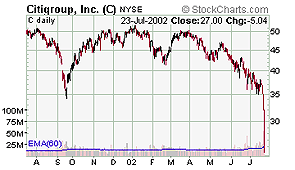 |
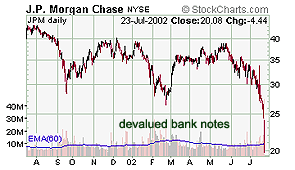 |
It isn't necessary to frown on the use of the word manipulation because it is inextricably inferred in any discussion of public policy objectives alone, many of which are so broad in scope we consider them as evidence of the bureaucracy subjugating capitalism. Keynes might well have said capitalism itself was a barbarous relic in this day where governments manage the free market system or the invisible hand, without apparent retribution. For pete's sake, even highly regarded journalists no less than frequently praise the US government for the management of its economy and currency. How can the word manipulation be frowned upon when governments engage in so much blatant economic management it borders on central planning? Commentators and analysts infer it all the time but never say it.
My friend and I continue to have this conversation nevertheless at higher and higher gold prices, and I expect we'll have them at higher prices still.
At some point, however, I think market participants will become convinced of the opposite argument - that the government has little control or perhaps even that it is impossible to control markets and sterilize that activity with any degree of ultimate success, at least in terms of the objectives a given policy sets out to accomplish. Why, it's true, and recorded throughout history. But wouldn't it be a coup for rational expectations theory if people actually believed it?
They will eventually I suspect though by that time the smart money, whoever they'll be, will be on the other side of the market because that'll probably be a sign the bull market is nearing an end, or such is the axiom of contrarian style thinking.
In reality I'd say the smart money will probably be promoting gold stock deals worth nothing at a huge premium. At least that's how society defines smart money today.
Cynically.
Whether or not there exists a clandestine group of bankers conspiring to suppress the price of gold in order to support the value of the dollar and their own dollar denominated investments, as is logical to presume there would be, how can we describe what has been happening with the price of gold and key economic structures (such as the stock market) since 2000 as anything but a failure of policy implementations, whatever they may be? Obviously, the rout in stock prices and corporate profits can't be the aim of policy, at least not any kind of policy we've ever witnessed.
And I don't know that bankers with large quantities of dollar investments would have agreed to allow a rally in gold prices and gold shares over the past year and a half, if they had any say in it. Whether they did or didn't, the rising price of gold probably makes them uncomfortable, particularly if it has been rising due to the reasons we gold bulls claim it is.
Dollar Bounce Hits Gold Hard
Despite the unexpected correction in gold prices on a falling dollar since
early June, we contend that the rally which began more than a year ago
essentially predicted today's dollar rout, and we also contend that the
activity in dollar and stock markets itself telegraphs further problems
for the dollar. A meaningful correction in the price of gold would require
a meaningful comeback in the value of the US dollar in our opinion.
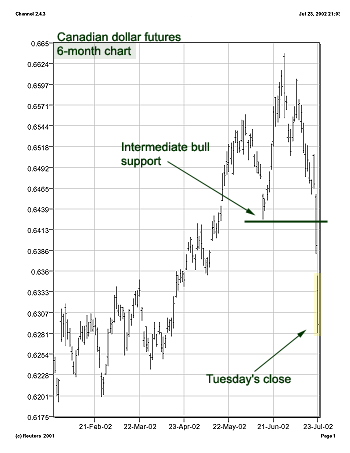 Otherwise,
Tuesday's $10 drop is simply another buying opportunity that will prove
itself at that point when investors perceive increasingly significant
downside to the currency. It's as simple as that.
Otherwise,
Tuesday's $10 drop is simply another buying opportunity that will prove
itself at that point when investors perceive increasingly significant
downside to the currency. It's as simple as that.
On Tuesday, the US dollar jumped 2% against the Euro while simultaneously crashing the Canadian dollar and Australian dollar both today and yesterday. Both currencies were down more than 1.5%, after similar drops Monday. The Canadian dollar sent us an intermediate bear market signal yesterday, and confirmed it today. The CRB fell 1.7% on declines copper, oil, and gold. Copper prices sent us an intermediate bear market signal also.
The chalk marks suggest a short term comeback for the dollar, coupled with a rise in bogus deflation sentiment, unless the bounce is combined with a recovery on Wall Street, in which case it'll be recovery sentiment. Those are the main factors that are driving the bearish gold market sentiment this week, in our opinion, and over and above the aura of manipulation in the air as a result of the coincidental crash in bank shares yesterday and today.
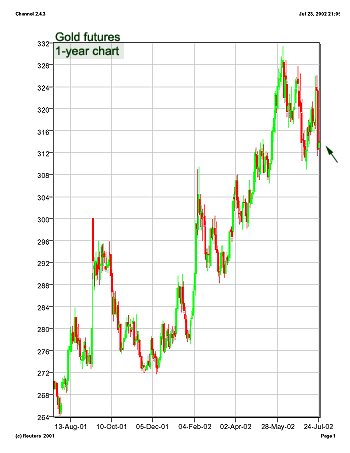 At
any rate, if the selling in gold were coming from any of the known bullion
banks it would surprise us in this day when off-balance sheet accounting
abuses attract the scrutiny of angry regulators like bees to honey. That
wouldn't mean they're not selling, just not necessarily from their own
accounts. I don't doubt their resourcefulness on that technical issue.
But maybe it shouldn't surprise us if they were selling right from their
own accounts. After all, the overvalued dollar is one reason we're in
this mess in the first place, and if their selling of bullion had anything
to do with that (a logical supposition) yet they continue to sustain the
same policy then who knows what they could possibly be thinking.
At
any rate, if the selling in gold were coming from any of the known bullion
banks it would surprise us in this day when off-balance sheet accounting
abuses attract the scrutiny of angry regulators like bees to honey. That
wouldn't mean they're not selling, just not necessarily from their own
accounts. I don't doubt their resourcefulness on that technical issue.
But maybe it shouldn't surprise us if they were selling right from their
own accounts. After all, the overvalued dollar is one reason we're in
this mess in the first place, and if their selling of bullion had anything
to do with that (a logical supposition) yet they continue to sustain the
same policy then who knows what they could possibly be thinking.
On the ethics and validity of the said policy, we have to ask, what kind of organization of anything continues to do the same thing after it brings negative consequences?
Maybe the kind we really need to worry about. Maybe it's the kind that resulted in Enron or WorldCom, and I don't mean that coyingly (if there's such a word). The comparison will become increasingly valid as one policy after another fails to rig the markets profitably, and the alleged economic managers lose credibility altogether.
It's the mentality of the operating modus operandi of the bankers that amazes us and is being revealed today, not just in front of the Congress, but also in the market. Their desperation is conspicuous and destructive. It's reminiscent of the kind of mentality that ruins companies, organizations, and in the end we could argue nations as well. We've been observing it for years, to the point that we labeled dollar policy the Machiavellian dollar. There appears to be an outright refusal to accept the idea that the free market is sufficient to heal a dislocated economy, and that any policy interference would only ultimately put off any such healing process.
How does one suppress the price of gold when it comes time that the market chooses to value it higher than the price at which it is "being stabilized" today? Markets tend to do this with or without approval when competing currencies are in trouble, but in those instances they fail to lift prices due to artificial forces they don't fail to drain supply.
Any commodity would just become scarcer, as was the case in the seventies when the government used price caps to try and control prices. Of course, the hope is that the apparent scarcity dissipates once financial assets are able to inflate again, demand for the US dollar rises again, and corporate profitability returns to support such valuations.
Wall Street Bulls Fail to Ignite Bounce
What bulls will do never seizes to amaze me. The sparkle in her eye when
Consuelo Mack discovered an indicator that never fails wasn't spared for
CNBC's audience, neither were any of the other host's glitter after applauding
her interview with Laszlo Birinyi of Deutsche Bank.
Basically he came on and said nothing works! No indicators work all the time. What a performance. Consuelo looked utterly disappointed at the fact that she had to go public with the news that this man of experience and depth said there were no reliable leading indicators to a bull market.
Thank you, we've been saying that all along. There aren't really. All of them have caveats. Even the fact that the advance/decline line topped out two years before the major market averages did is a very early leading indicator. Too early for practical implementation. Traders following that lead turned bearish far too early, which is not always bad, unless the objective is to go short right away.
With disappointment in her expression Consuelo asked one more time, isn't there even one indicator that works consistently as a lead? Birinyi bashfully admitted there might be. "What is it," she asked with anticipation? Birinyi said it was when the public's short position exceeded the professional short position.
The interview came to an end with a brief display of excitement from her and her colleagues at CNBC immediately followed by about a 10-point bounce in the Dow when she admitted that Mr. Birinyi phoned Tuesday morning with the great news, that the indicator was predicting a bottom (ostensibly the interview wasn't recorded today) because the public's short position had just exceeded the professional position.
So it seemed as though they agreed not to air it until the indicator flashed a buy signal. How convenient. To be fair, I'm sure he didn't want everyone in the world watching the same indicator at the same time before it had a chance to work.
That settles it then. Birinyi and his clients must be making so much money if they've got the only market indicator that works. Or does it? I'm just wondering because I know a bridge in Brooklyn that's for sale. If Birinyi's indicator does indeed work as claimed it's a new discovery. I'd found a few quotes from an article in Business Week from back in December 2001 titled "Why Laszlo Birinyi's Compass Points Up."
The Dow was struggling with 10000 then, and the tech sector Birinyi was particularly fond of was at 2000 measured by the Nasdaq Composite. The former is down 25%, and the latter is down almost by half since then. Here's some of what was said:
This savvy market strategist says money flows into stocks are signaling a change for the better in investor confidence (12 Dec 01):
His expertise is mainly in being able to pinpoint where the big cash in the market is going and which areas of the market it's having an impact on. So it's not surprising that Birinyi's market opinion is highly valued."POSITIVE SIGN." With 2001 near the end, is he now bullish or bearish? "He who has the gold makes the rules," says Birinyi, quoting an old market cliché. "Our view going forward is that the stock market will continue higher in the long term as money flows on the Dow Jones industrial average are constructive," declares Birinyi. It shows that investors have taken advantage of price dips -- which is a very positive sign, he says. "People are becoming more confident," Birinyi says, and this is supported, by the "classical technical approaches" that he sees in the market today.
Among these technical factors: The advance/decline line on the New York Stock Exchange is "confirming" the move - December 12, 2001 - Business Week.
Oh Ok, I guess he didn't know back then that the advance/decline line has always stopped going down on the last day of a bear market, as he revealed for us in the interview today. Nice try Consuelo.
Many bulls have been gradually throwing in the towel on the capitulation sell off idea for Wall Street that just happens to be underway right now. Maybe they got long a wee bit early.
That's a bad sign. Bulls continue to bravely call bottoms, and mainstreet continues to put out the stopped clocks. I wonder what it means? When will it end?
At the bottom! - as usual.
By the way, does the alleged pro position in this new indicator take into account the government's position - through the ESF or otherwise? Or would that just count as the public position?
I wouldn't know; I've never tested or looked at the indicator. It sounds sensible, but it's the calculation that would interest us, and the "implied" claim that there are no caveats to this one. I hope Laszlo tells us when the market has topped, and I sincerely would love his interpretation of the activity of the market immediately following the buy signal.
Yields
Fall, Gold Gets Cheaper
In the same way we question why gold prices continue to follow the downturn
in the fundamentals supporting the value of the dollar we could also ask
why the long bond has been trending up so weakly in light of a 3000-point
drop in the Dow since March?
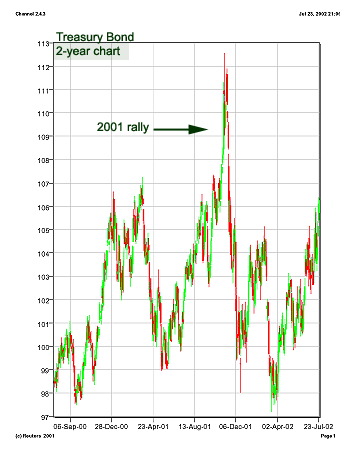 The
price of gold should soar if it has any monetary value and the value of
the dollar is in question. But if the value of the dollar is not in question,
the 30-year bond price should have gained more. In the prior 3300 point
slide in the Dow (May to Sep 2001) the long bond gained nearly 14% in
value. In the current climate it is only up about 9% from a lower intermediate
bottom. That said the shorter-term maturity's have matched their 2001
gains.
The
price of gold should soar if it has any monetary value and the value of
the dollar is in question. But if the value of the dollar is not in question,
the 30-year bond price should have gained more. In the prior 3300 point
slide in the Dow (May to Sep 2001) the long bond gained nearly 14% in
value. In the current climate it is only up about 9% from a lower intermediate
bottom. That said the shorter-term maturity's have matched their 2001
gains.
But none of the Treasuries are at new primary highs, as we might argue they should be, considering the fact this down leg in stock prices is at new primary lows itself. This hesitation, particularly evident in the long bond, leads us to believe the Treasury markets continue to factor some dollar weakness, rather than recovery. It's important because Treasury yields are invariably a policy tool, and they're still relatively sticky.
Historically, the 3 factors supporting the majority of the weight in the government's calculation of its leading index are Money Supply growth, changes in the interest rate spread, and changes in average weekly manufacturing hours, in that order. So as the yield curve steepens and buffers the index it is widely interpreted to imply a recovery in GDP.
We won't dispute that concept but the question is how much of the rate spread between the long and short end discounts a real recovery and how much of it discounts a nominal recovery? That's the conundrum that persistently plagues monetary policy makers in an environment of rampant inflation. Arguably, confidence in the leading indicator's ability to forecast recovery itself could influence that balance to an extent.
But on a day like today (Tue, Jul 23), with stock prices failing to find support again - though not for a lack of trying - and with a near 2 percent rebound in the dollar index, bond prices could've done better. The long bond gained 0.09% in price, and the 10-year gained 0.28%. Both have signaled an intermediate bull leg and they've both confirmed it with fresh highs on Tuesday, but only marginal ones.
Arguably it's not over, and a bounce in the dollar combined with falling commodity prices, as well as ongoing equity weakness is just what the doctor ordered for a buying spike in the long bond. We're not so sure about a material bounce in the US dollar, and thus a material decline in commodity prices, while stock prices continue to fall and weigh on the currency, however. As for stocks, the call is increasingly tough in the short term. I hate to ruin a good roll, but outside of the bull raid we're on the look out for this week, the market has barely hinted at halting the accelerated selling we've been witness to in July.
NYSE volumes grew over Monday and breadth was just as bearish.
The Nasdaq composite resumed a treacherous slide on Tuesday falling by more than 4%. The Dow held up better, and was even up almost 100 points a few times throughout the day, but ended down 82 points, or 1%, to close at nearly new four year lows. The S&P 500 finished at new five year lows. The S&P 600 small cap index landed only two points above the neckline of a large 30-month broadening speculative top, or so it will be if the index falls through 180. JP Morgan and Citigroup were off 18% and 15% respectively in the Dow and the former took out its 1998 low to make a fresh six-year low. AT&T, Microsoft, and Alcoa followed suit. Trading in MSFT after the bell was furious. The stock ended down more than 7% on huge after-hours volume, and even after a $4 pop that only drew more sellers out in droves.
It's the kind of stuff that dreams are made of for gold bulls. So what's the problem?
Policymakers are probably in full swing to stabilize financial markets and raiding gold prices is a strategy that has yielded variable success in the past in this regard. It is not very likely that it will work, but it is likely that the resolute attempts will continue until the very last round. Dollar bulls are acting like cornered animals unaware of the consequences of their potentially irrational actions, but committed to their own survival.
There's a lot at stake and Laszlo does indeed say it best when he says that "He who has the gold makes the rules…" The question is who owns the gold today?
After accounting for our medium to long range outlook for dollar assets perhaps the better question is what is that gold going to go for when they come back for it?